technical specifications Seat Altea 2013 Manual PDF
[x] Cancel search | Manufacturer: SEAT, Model Year: 2013, Model line: Altea, Model: Seat Altea 2013Pages: 315, PDF Size: 4.66 MB
Page 145 of 315
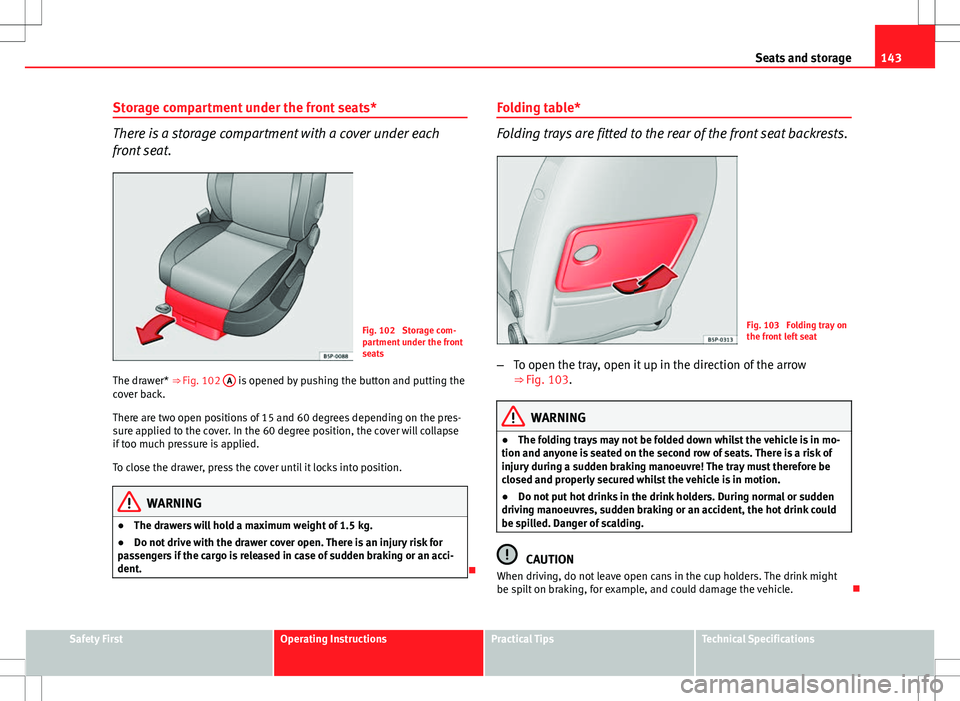
143
Seats and storage
Storage compartment under the front seats*
There is a storage compartment with a cover under each
front seat.
Fig. 102 Storage com-
partment under the front
seats
The drawer* ββFig. 102 A
is opened by pushing the button and putting the
cover back.
There are two open positions of 15 and 60 degrees depending on the pres-
sure applied to the cover. In the 60 degree position, the cover will collapse
if too much pressure is applied.
To close the drawer, press the cover until it locks into position.
WARNING
β The drawers will hold a maximum weight of 1.5 kg.
β Do not drive with the drawer cover open. There is an injury risk for
passengers if the cargo is released in case of sudden braking or an acci-
dent.
ο Folding table*
Folding trays are fitted to the rear of the front seat backrests.
Fig. 103 Folding tray on
the front left seat
β To open the tray, open it up in the direction of the arrow
ββFig. 103.
WARNING
β The folding trays may not be folded down whilst the vehicle is in mo-
tion and anyone is seated on the second row of seats. There is a risk of
injury during a sudden braking manoeuvre! The tray must therefore be
closed and properly secured whilst the vehicle is in motion.
β Do not put hot drinks in the drink holders. During normal or sudden
driving manoeuvres, sudden braking or an accident, the hot drink could
be spilled. Danger of scalding.
CAUTION
When driving, do not leave open cans in the cup holders. The drink might
be spilt on braking, for example, and could damage the vehicle. ο
Safety FirstOperating InstructionsPractical TipsTechnical Specifications
Page 147 of 315
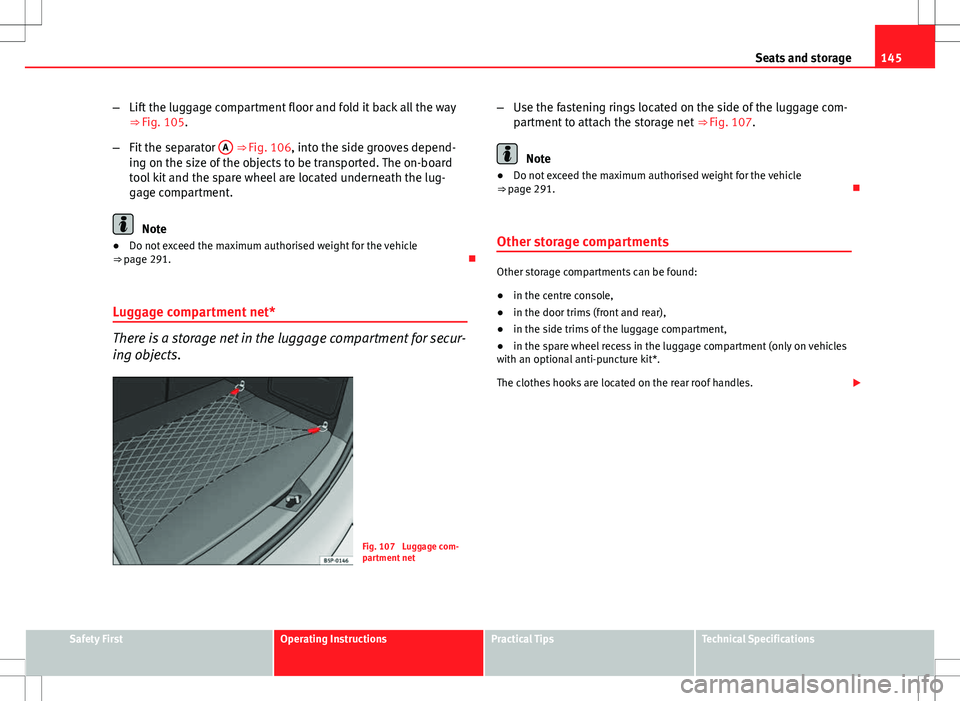
145
Seats and storage
β Lift the luggage compartment floor and fold it back all the way
ββFig. 105.
β Fit the separator A
ββFig. 106, into the side grooves depend-
ing on the size of the objects to be transported. The on-board
tool kit and the spare wheel are located underneath the lug-
gage compartment.
Note
β Do not exceed the maximum authorised weight for the vehicle
ββpage 291. ο
Luggage compartment net*
There is a storage net in the luggage compartment for secur-
ing objects.
Fig. 107 Luggage com-
partment net β
Use the fastening rings located on the side of the luggage com-
partment to attach the storage net ββFig. 107.
Note
β Do not exceed the maximum authorised weight for the vehicle
ββpage 291. ο
Other storage compartments
Other storage compartments can be found:
β in the centre console,
β in the door trims (front and rear),
β in the side trims of the luggage compartment,
β in the spare wheel recess in the luggage compartment (only on vehicles
with an optional anti-puncture kit*.
The clothes hooks are located on the rear roof handles. ο£
Safety FirstOperating InstructionsPractical TipsTechnical Specifications
Page 149 of 315
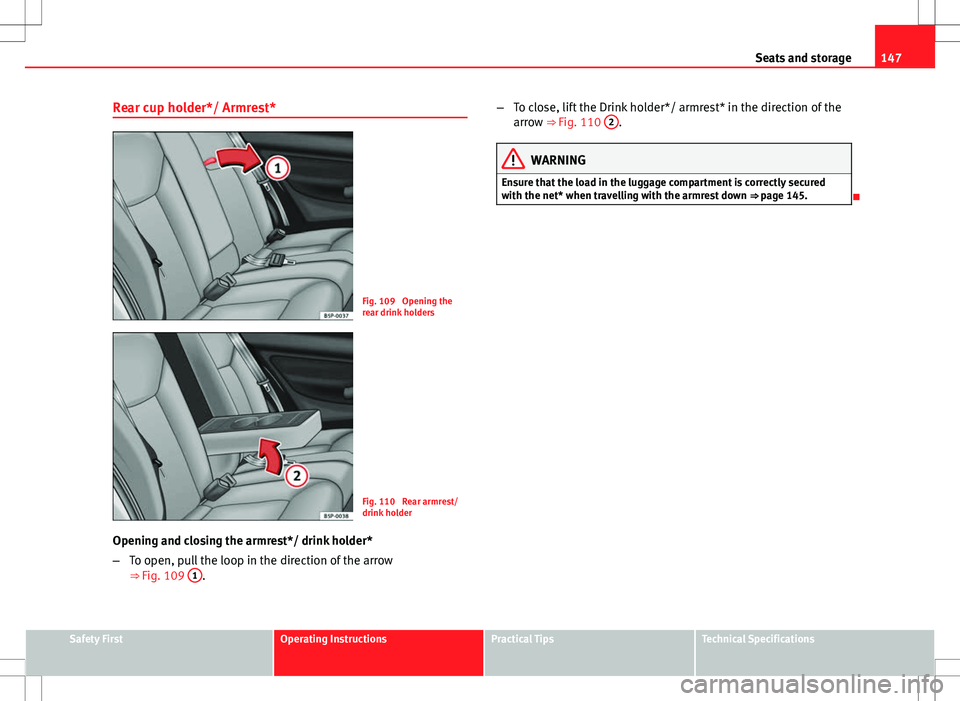
147
Seats and storage
Rear cup holder*/ Armrest*
Fig. 109 Opening the
rear drink holders
Fig. 110 Rear armrest/
drink holder
Opening and closing the armrest*/ drink holder*
β To open, pull the loop in the direction of the arrow
ββFig. 109 1
. β
To close, lift the Drink holder*/ armrest* in the direction of the
arrow ββFig. 110 2
.
WARNING
Ensure that the load in the luggage compartment is correctly secured
with the net* when travelling with the armrest down ββpage 145.
ο
Safety FirstOperating InstructionsPractical TipsTechnical Specifications
Page 151 of 315
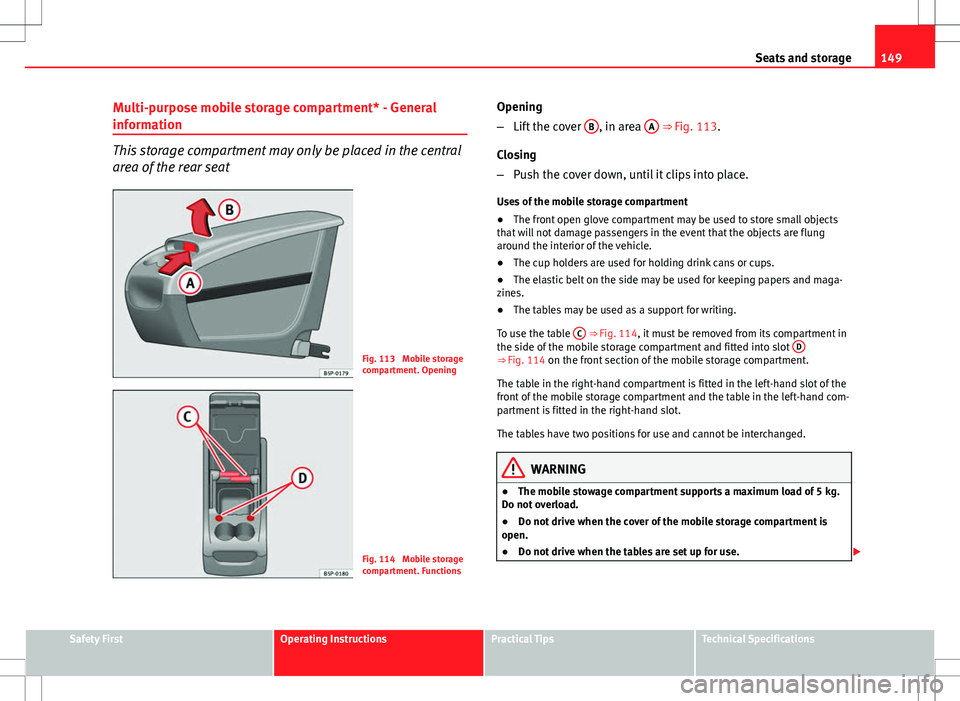
149
Seats and storage
Multi-purpose mobile storage compartment* - General
information
This storage compartment may only be placed in the central
area of the rear seat
Fig. 113 Mobile storage
compartment. Opening
Fig. 114 Mobile storage
compartment. Functions Opening
β
Lift the cover B
, in area A ββFig. 113.
Closing
β Push the cover down, until it clips into place.
Uses of the mobile storage compartment
β The front open glove compartment may be used to store small objects
that will not damage passengers in the event that the objects are flung
around the interior of the vehicle.
β The cup holders are used for holding drink cans or cups.
β The elastic belt on the side may be used for keeping papers and maga-
zines.
β The tables may be used as a support for writing.
To use the table C
ββFig. 114, it must be removed from its compartment in
the side of the mobile storage compartment and fitted into slot D
ββFig. 114 on the front section of the mobile storage compartment.
The table in the right-hand compartment is fitted in the left-hand slot of the
front of the mobile storage compartment and the table in the left-hand com-
partment is fitted in the right-hand slot.
The tables have two positions for use and cannot be interchanged.
WARNING
β The mobile stowage compartment supports a maximum load of 5 kg.
Do not overload.
β Do not drive when the cover of the mobile storage compartment is
open.
β Do not drive when the tables are set up for use. ο£
Safety FirstOperating InstructionsPractical TipsTechnical Specifications
Page 153 of 315
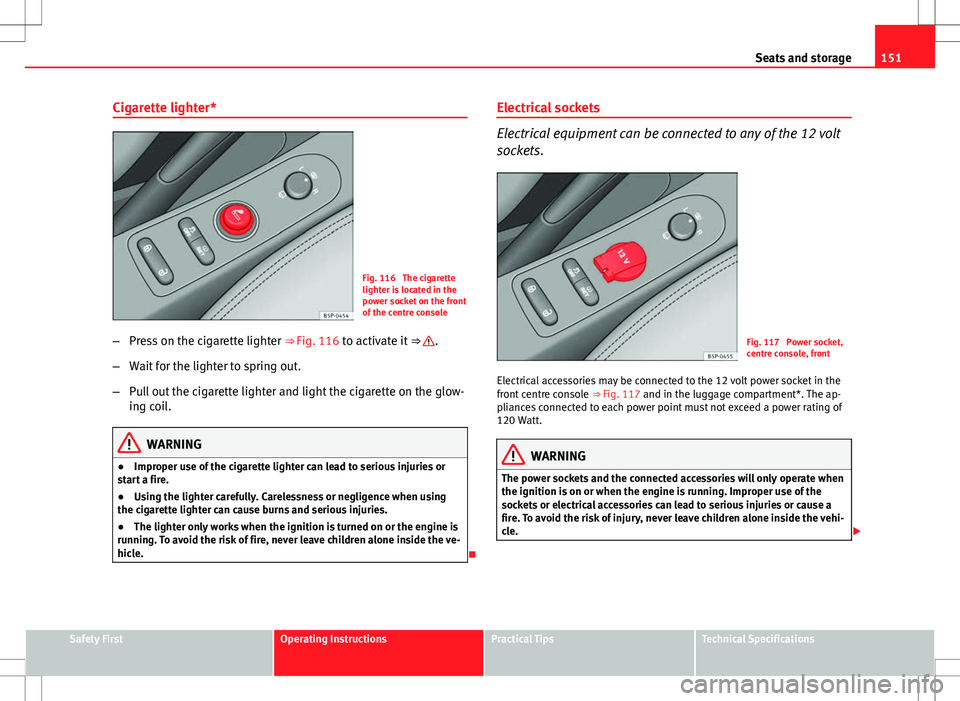
151
Seats and storage
Cigarette lighter*
Fig. 116 The cigarette
lighter is located in the
power socket on the front
of the centre console
β Press on the cigarette lighter ββFig. 116 to activate it ββ
.
β Wait for the lighter to spring out.
β Pull out the cigarette lighter and light the cigarette on the glow-
ing coil.
WARNING
β Improper use of the cigarette lighter can lead to serious injuries or
start a fire.
β Using the lighter carefully. Carelessness or negligence when using
the cigarette lighter can cause burns and serious injuries.
β The lighter only works when the ignition is turned on or the engine is
running. To avoid the risk of fire, never leave children alone inside the ve-
hicle.
ο Electrical sockets
Electrical equipment can be connected to any of the 12 volt
sockets.
Fig. 117 Power socket,
centre console, front
Electrical accessories may be connected to the 12 volt power socket in the
front centre console ββFig. 117 and in the luggage compartment*. The ap-
pliances connected to each power point must not exceed a power rating of
120 Watt.
WARNING
The power sockets and the connected accessories will only operate when
the ignition is on or when the engine is running. Improper use of the
sockets or electrical accessories can lead to serious injuries or cause a
fire. To avoid the risk of injury, never leave children alone inside the vehi-
cle. ο£
Safety FirstOperating InstructionsPractical TipsTechnical Specifications
Page 155 of 315
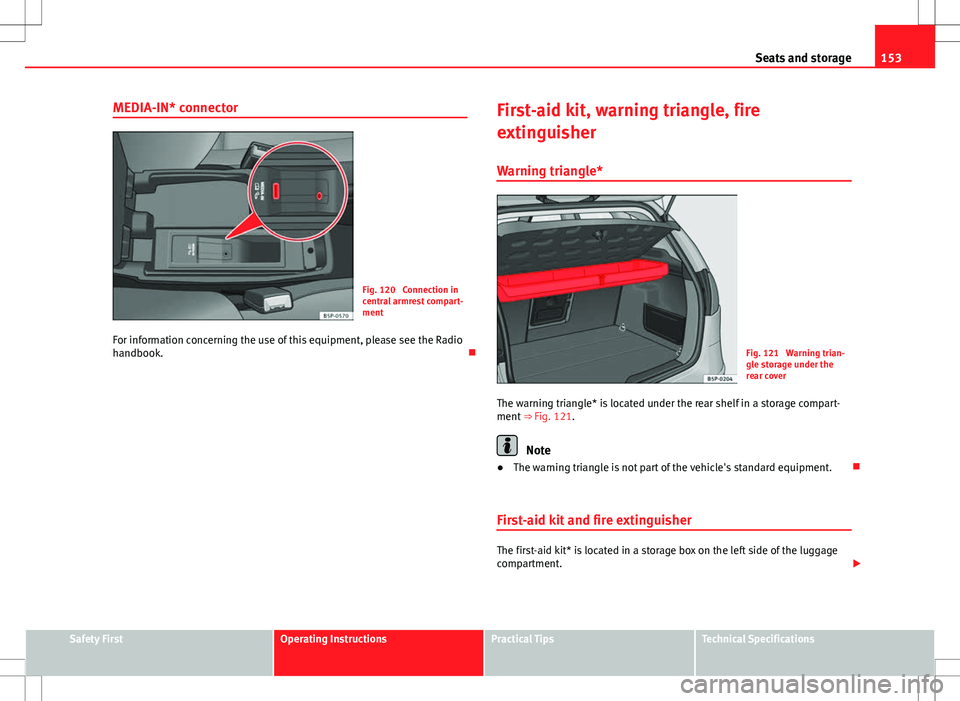
153
Seats and storage
MEDIA-IN* connector
Fig. 120 Connection in
central armrest compart-
ment
For information concerning the use of this equipment, please see the Radio
handbook. οFirst-aid kit, warning triangle, fire
extinguisher
Warning triangle*
Fig. 121 Warning trian-
gle storage under the
rear cover
The warning triangle* is located under the rear shelf in a storage compart-
ment ββFig. 121.
Note
β The warning triangle is not part of the vehicle's standard equipment. ο
First-aid kit and fire extinguisher
The first-aid kit* is located in a storage box on the left side of the luggage
compartment. ο£
Safety FirstOperating InstructionsPractical TipsTechnical Specifications
Page 157 of 315
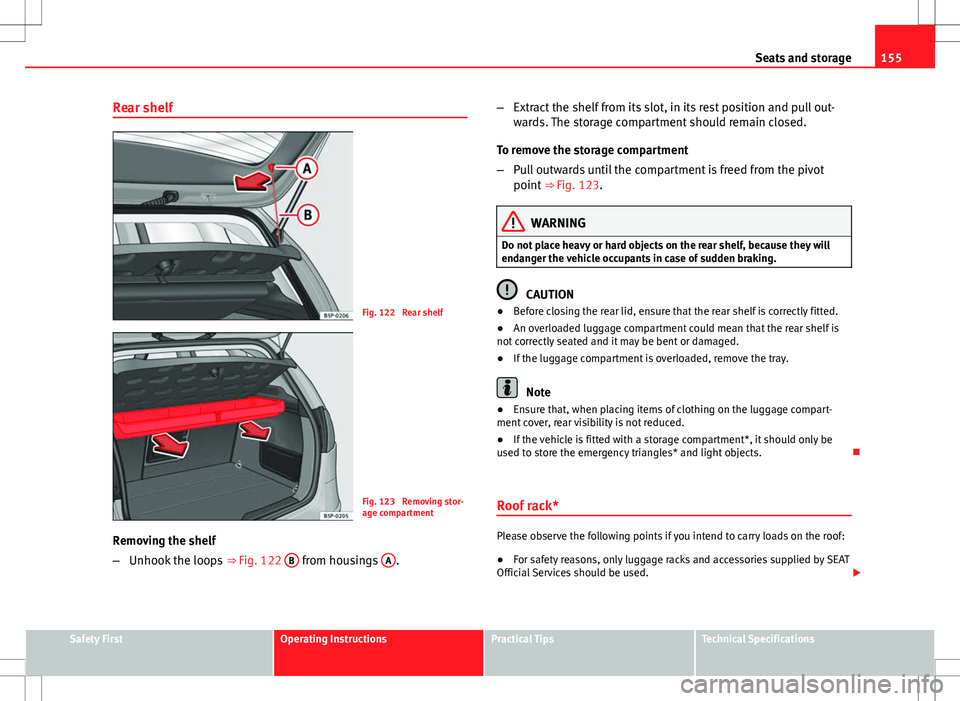
155
Seats and storage
Rear shelf
Fig. 122 Rear shelf
Fig. 123 Removing stor-
age compartment
Removing the shelf
β Unhook the loops ββFig. 122 B
from housings A. β
Extract the shelf from its slot, in its rest position and pull out-
wards. The storage compartment should remain closed.
To remove the storage compartment
β Pull outwards until the compartment is freed from the pivot
point ββFig. 123.
WARNING
Do not place heavy or hard objects on the rear shelf, because they will
endanger the vehicle occupants in case of sudden braking.
CAUTION
β Before closing the rear lid, ensure that the rear shelf is correctly fitted.
β An overloaded luggage compartment could mean that the rear shelf is
not correctly seated and it may be bent or damaged.
β If the luggage compartment is overloaded, remove the tray.
Note
β Ensure that, when placing items of clothing on the luggage compart-
ment cover, rear visibility is not reduced.
β If the vehicle is fitted with a storage compartment*, it should only be
used to store the emergency triangles* and light objects. ο
Roof rack*
Please observe the following points if you intend to carry loads on the roof:
β For safety reasons, only luggage racks and accessories supplied by SEAT
Official Services should be used. ο£
Safety FirstOperating InstructionsPractical TipsTechnical Specifications
Page 159 of 315
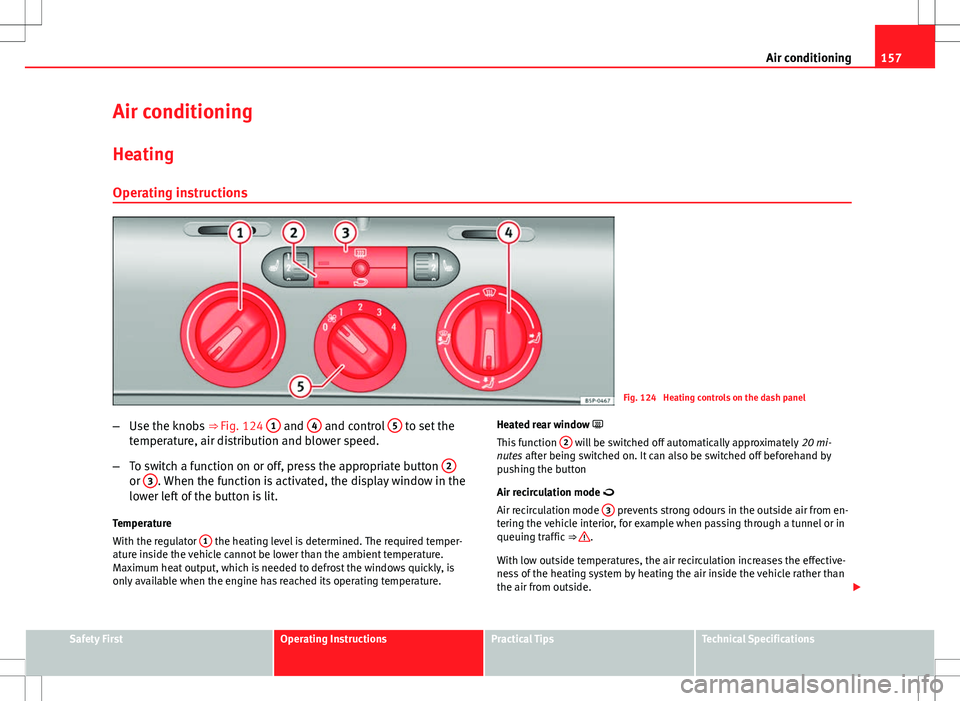
157
Air conditioning
Air conditioning Heating
Operating instructions
Fig. 124 Heating controls on the dash panel
β Use the knobs ββFig. 124 1
and 4 and control 5 to set the
temperature, air distribution and blower speed.
β To switch a function on or off, press the appropriate button 2
or 3. When the function is activated, the display window in the
lower left of the button is lit.
Temperature
With the regulator 1
the heating level is determined. The required temper-
ature inside the vehicle cannot be lower than the ambient temperature.
Maximum heat output, which is needed to defrost the windows quickly, is
only available when the engine has reached its operating temperature. Heated rear window ο
This function
2
will be switched off automatically approximately
20 mi-
nutes after being switched on. It can also be switched off beforehand by
pushing the button
Air recirculation mode ο
Air recirculation mode 3
prevents strong odours in the outside air from en-
tering the vehicle interior, for example when passing through a tunnel or in
queuing traffic ββ
.
With low outside temperatures, the air recirculation increases the effective-
ness of the heating system by heating the air inside the vehicle rather than
the air from outside. ο£
Safety FirstOperating InstructionsPractical TipsTechnical Specifications
Page 161 of 315
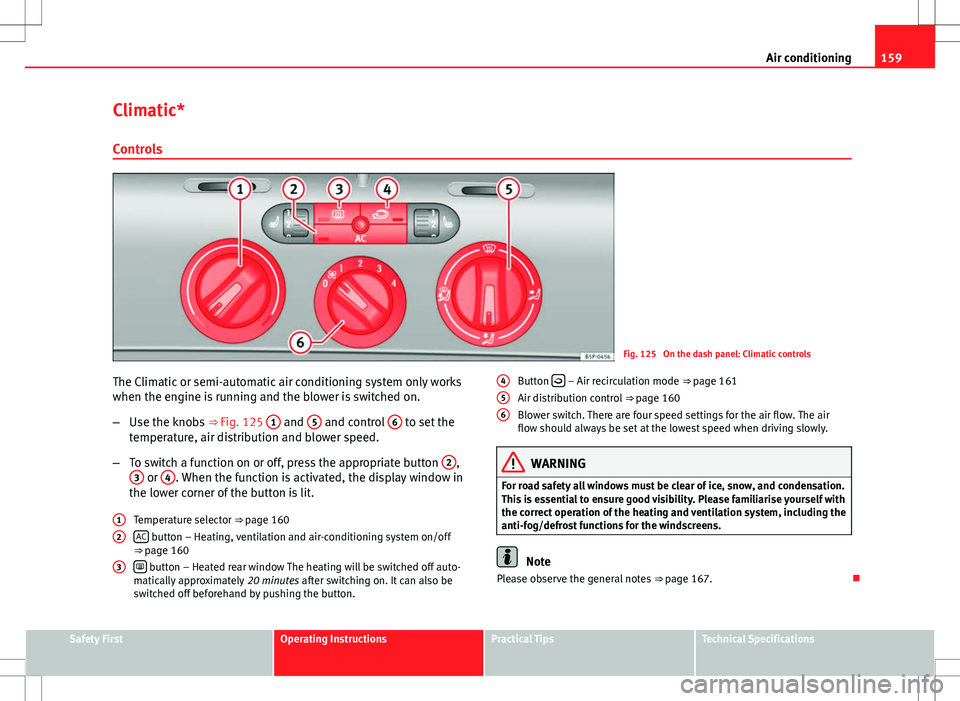
159
Air conditioning
Climatic* Controls
Fig. 125 On the dash panel: Climatic controls
The Climatic or semi-automatic air conditioning system only works
when the engine is running and the blower is switched on.
β Use the knobs ββFig. 125 1
and 5 and control 6 to set the
temperature, air distribution and blower speed.
β To switch a function on or off, press the appropriate button 2
,
3 or 4. When the function is activated, the display window in
the lower corner of the button is lit.
Temperature selector ββ page 160
AC
button β Heating, ventilation and air-conditioning system on/off
ββ page 160
ο
button β Heated rear window The heating will be switched off auto-
matically approximately 20 minutes after switching on. It can also be
switched off beforehand by pushing the button.
1
2
3
Button
ο β Air recirculation mode ββpage 161
Air distribution control ββpage 160
Blower switch. There are four speed settings for the air flow. The air
flow should always be set at the lowest speed when driving slowly.
WARNING
For road safety all windows must be clear of ice, snow, and condensation.
This is essential to ensure good visibility. Please familiarise yourself with
the correct operation of the heating and ventilation system, including the
anti-fog/defrost functions for the windscreens.
Note
Please observe the general notes ββpage 167. ο
4
56
Safety FirstOperating InstructionsPractical TipsTechnical Specifications
Page 163 of 315
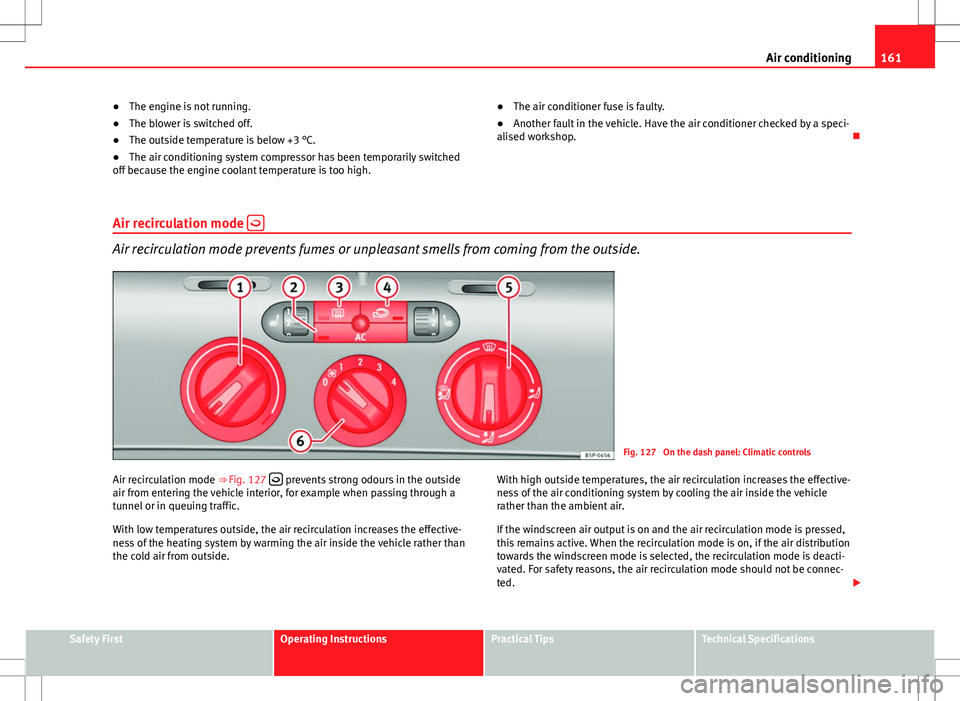
161
Air conditioning
β The engine is not running.
β The blower is switched off.
β The outside temperature is below +3 Β°C.
β The air conditioning system compressor has been temporarily switched
off because the engine coolant temperature is too high. β
The air conditioner fuse is faulty.
β Another fault in the vehicle. Have the air conditioner checked by a speci-
alised workshop. ο
Air recirculation mode ο
Air recirculation mode prevents fumes or unpleasant smells from coming from the outside.
Fig. 127 On the dash panel: Climatic controls
Air recirculation mode ββFig. 127 ο
prevents strong odours in the outside
air from entering the vehicle interior, for example when passing through a
tunnel or in queuing traffic.
With low temperatures outside, the air recirculation increases the effective-
ness of the heating system by warming the air inside the vehicle rather than
the cold air from outside. With high outside temperatures, the air recirculation increases the effective-
ness of the air conditioning system by cooling the air inside the vehicle
rather than the ambient air.
If the windscreen air output is on and the air recirculation mode is pressed,
this remains active. When the recirculation mode is on, if the air distribution
towards the windscreen mode is selected, the recirculation mode is deacti-
vated. For safety reasons, the air recirculation mode should not be connec-
ted.
ο£
Safety FirstOperating InstructionsPractical TipsTechnical Specifications